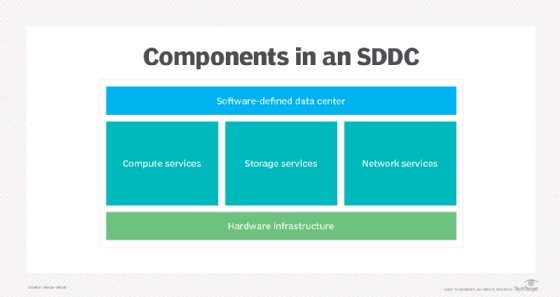What is a software-defined data center (SDDC)?
What is a SDDC?
A software-defined data center (SDDC) is a server management concept in which all infrastructure elements -- networking, storage and compute -- are virtualized and delivered as a service. Deployment, operation, provisioning and configuration are abstracted from hardware. Those tasks are implemented through software interfaces.
Former VMware CTO Steve Herrod is widely credited with coining the term around 2012. SDDC is mainly associated with VMware products, but the principles of fully virtualized environments have been implemented by many providers.
SDDC is becoming more common in enterprise environments. It has been adopted by cloud service providers and data-center-as-a-service providers. It is supported by Amazon, Microsoft Azure, Google and the Open Compute Project.
In an SDDC administrators can quickly create and remove entire services with only a few simple commands from an administrator. This makes them almost a necessity for DevOps and infrastructure as code (IaC) initiatives.
Components of an SDDC
Virtualization is central to the software-defined data center. There are three major SDDC building blocks:
- Network virtualization and software-defined networking (SDN) abstracts the physical network resources from the logical network topology. It allows for combining network resources and splitting the available bandwidth into independent channels that can each be assigned -- or reassigned -- to a particular server or device in real time.
- Storage virtualization pools physical storage from multiple network storage devices into what appears to be a single storage device managed from a central console. These pools of storage can then be subdivided into high-performance virtual disks of which the software makes use.
- Server virtualization masks server resources -- including the number and identity of individual physical servers, processors and RAM -- from server users. The intention is to spare the service administrators from managing complicated server-resource details or worrying about the physical server characteristics. It also increases resource sharing and utilization, while maintaining the ability to easily expand capacity later.

A business-logic layer is needed to translate application requests, policies and service-level agreements.
SDDC benefits and challenges
A software-defined data center is a way to dynamically configure and provision applications, infrastructure and IT resources. The design allows the data center to be managed as a unified system or aggregate set of domains. A key factor is the separation of control planes and data planes.
An SDDC provides an organization with its own private cloud for better control of hosted services and data. It allows for the same level of flexibility to create and remove servers that many developers have become used to, but on enterprise-owned hardware.
Software-defined data centers capitalize on the agility, elasticity and scalability of cloud computing techniques. The chief advantage is automating all functions through intelligent software, especially manually intensive tasks related to provisioning and operational management.
This allows for a high degree of flexibility within a traditional data center. Resources are pooled and provisioned in the manner of a public cloud or hybrid cloud. Workloads operate independently of the physical IT infrastructure.
Both infrastructure management and workload management are controlled programmatically. The intended result is to reduce costs and management overhead, while increasing IT agility and flexibility.
An SDDC implementation is often composed of different components from various vendors. That complicates planning and integration of SDDC architecture, although enterprises can avoid vendor lock-in as a result.
SDDC market share
The software-defined data center evolved from x86 server virtualization, which VMware introduced around 2006. Processing power and memory are decoupled from hardware and presented as shared resources. Instead of running on bare metal, each application is contained in a virtual machine, which hosts a full guest copy of the OS.
VMware vCloud Suite is an integrated tool for building and managing a vSphere private cloud designed on SDDC architecture.
The SDDC market is broken into segments relating to products for software-defined compute, software-defined networking and software-defined storage. Market research firm Fortune Business Insights estimates the SDDC market will grow to $71.09 billion dollars in 2024 (up from $58.04 billion in 2023) and by 2032 hit $307.79 billion, a compound annual growth rate of 20.1%.
There are two approaches to fully virtualizing a data center. The first is transitional, in which existing hardware and equipment runs in parallel with newer SDDC gear. The second approach involves integrating existing and new equipment within a unified data center fabric.
Future of SDDC
Just as isolated networks evolved into the internet, SDDCs have had similar effects on computing in the data center. The ability to abstract the application layer from underlying physical hardware allows for agile development practices and quick response to changing business needs.
SDDC provides a common virtual infrastructure for migrating computing resources on demand between private, public and hybrid clouds.
As SDDCs mature, the abstraction of data center technologies by software requires enterprises to revamp IT security. Heightened collaboration between security and virtualization teams can help identify and defuse potential threats. Integrating security in software enables an organization to quickly adapt and orchestrate policies to counter emerging threats. An example is setting security policies based on the application, its content or users.
Software-defined data centers alter business buying criteria, eliminates conventional IT team silos and necessitates organizational investment in admin skill sets. Explore five ways SDDCs and virtualization management change business operations.






